All about dishwashing sponges
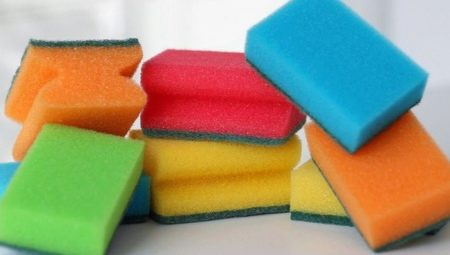
Despite the increasing popularity of dishwashers, the traditional hand washing with sponges is still relevant. Most of us are used to using just a couple of different types of sponges for cleaning almost all surfaces in the house. However, this is not entirely the correct approach. A large number of their types on the modern market are not only a marketing ploy to increase sales, they are tools that help to cope with different types of dirt without damaging the surface. Read everything about the nuances of the variety of sponges, their use, storage, selection and much more in this article.

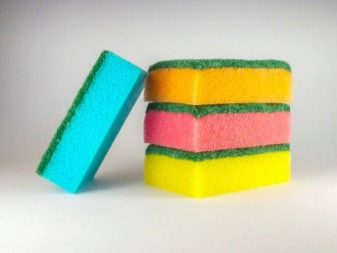
Variety of species
Every year the range of dishwashing sponges is expanding. For more efficient cleaning, it is recommended to have several varieties of these products in stock at home.

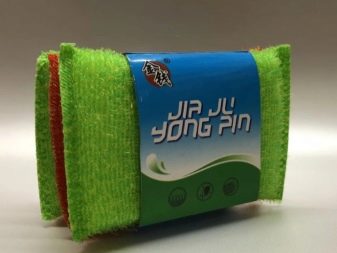
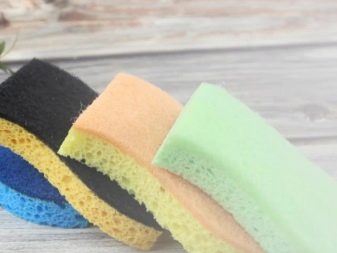
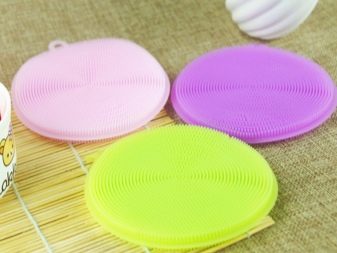
Foam
Perhaps the most common and most versatile sponge. It is them that many people around the world use for washing dishes. It has a characteristic porous structure, due to which it absorbs water easily, quickly and in large quantities, and is also capable of creating foam. The latter is possible even if the surfaces are washed with laundry soap.
It is made of polyurethane foam, which, according to GOST, should be 85% air. Generally works well with any detergent.
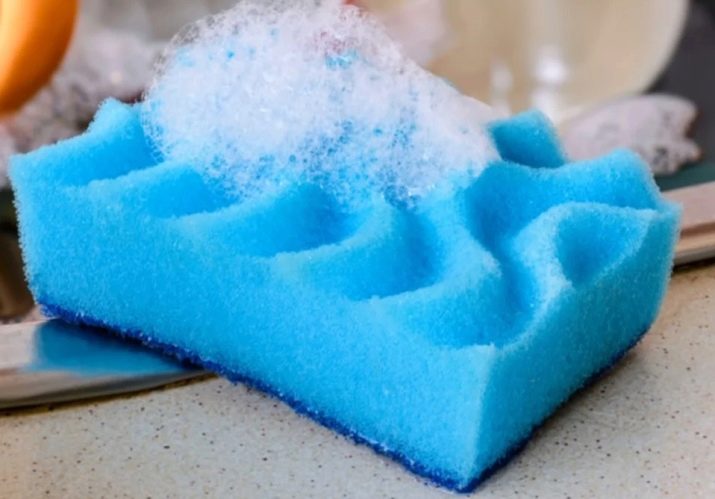
Manufacturers make such products not of high quality; with careful use, the average service life is from 2 to 3 weeks.However, this is only if you do not use it to wash dishes. Otherwise, the service life is reduced. It is a homogeneous porous rectangular sponge. Sometimes there are samples with rounded sides, as well as in the shape of a figure eight. The first foam rubber models were released back in 1937.
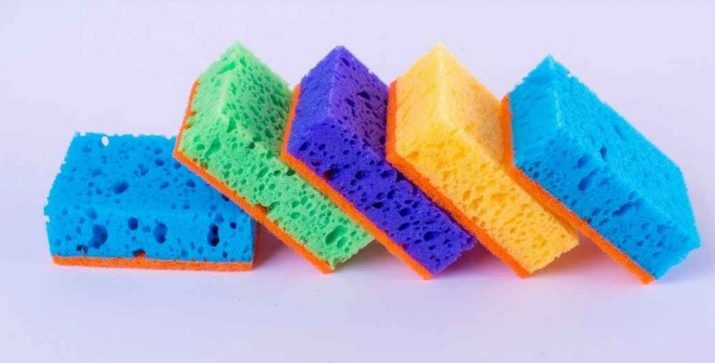
Abrasive
This is another version of the classic sponge that most people have at home. They look like small rectangular products, a distinctive feature of which is a rigid base located on the larger side. They can be of different colors, but more often they are yellow. It is believed that the hard part of the sponge is used to wash the dishes with a detergent, and the soft side is to rinse the dishes with water. It can also be used to clean slabs, other surfaces, furniture, sinks, bathtubs, tiles, glass and other surfaces. They differ in a relatively long service life with proper care - up to 1 month.
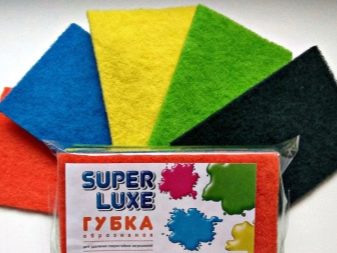
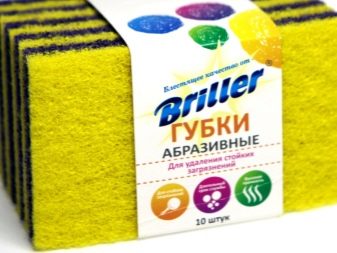
Cellulosic
This kind of sponge is often made not of cellulose, as it might seem, but of viscose. However, both materials are natural and environmentally friendly and do not cause irritation or allergies. To the touch, such sponges are quite soft, but elastic, pimpled. They have a more dense structure than foam analogs. The main feature is that they are antibacterial... They are durable, can keep their shape for a long period, can be used to clean any surface. They are more expensive than abrasive models.
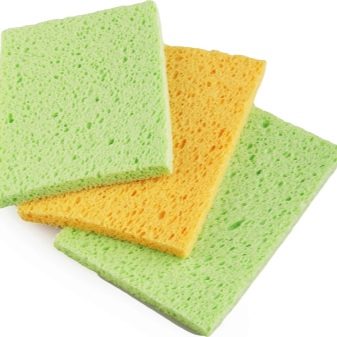
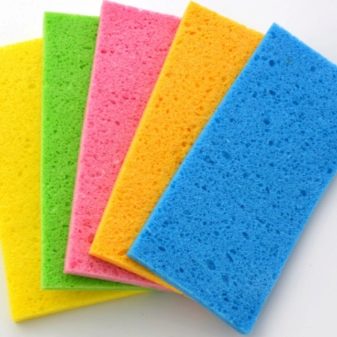
Metallic
They are a coil of fine wire. The color is gray, sometimes it can be blackish with a metallic shade and the same shine. Suitable for combating stubborn dirt or old grease. May leave marks on sensitive surfaces and can scratch the skin of the hands.
Do not wash ceramic, enamel or Teflon-coated dishes with a metal sponge.
Usually used for cleaning baking sheets, cauldrons, skewers, pans and other resistant surfaces. They are distinguished by a long service life due to their infrequent use and the solid structure of the material of manufacture.
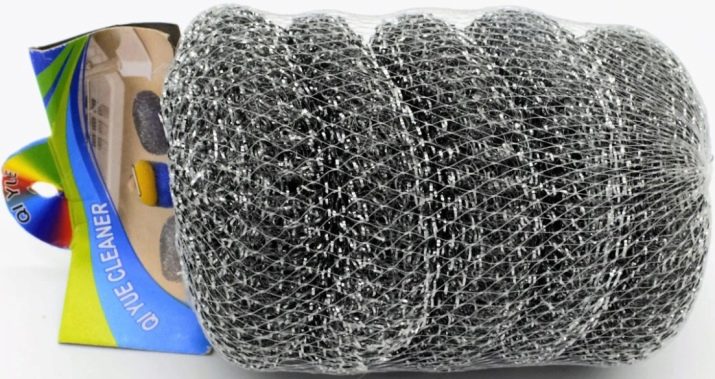
Silicone
They are flat sponges with many small fibers. They are a relatively new product on the market. They wash well almost any dirt, except for too strong. Such a sponge does not spoil the surface of the dishes, is not a source of bacterial growth, since it does not absorb moisture. Requires a lot of detergent when washing dishes. Virtually no foam. It can be used for other purposes as well: it washes the dirt on clothes, even it is used as a brush for washing the face. Replacement requires every few months.
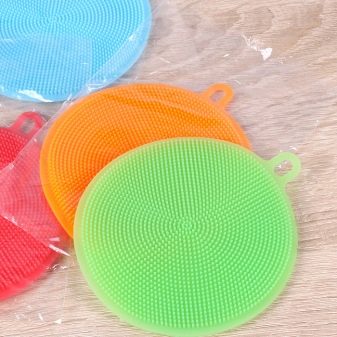
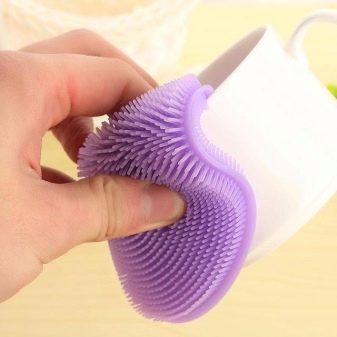
Plastic
They look like metal sponges. They are much softer to the touch and usually come in vibrant colors. Made from fine plastic fibers. Designed for washing dishes that require careful handling. Practically no foam as the holes between the fibers are too large. In general, they can serve for quite a long time.
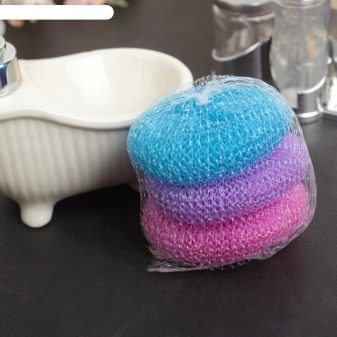
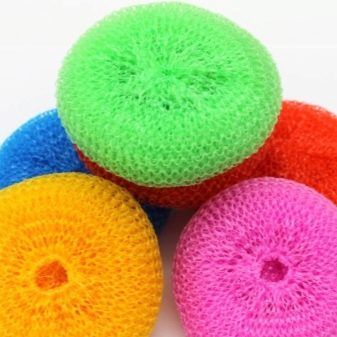
Melamine
Melamine or white sponges are made from melamine resin. They are also called "household eraser". Due to the fact that resin particles can be released from the product during washing the surface, it is considered toxic. They are intended only for washing the outer surface of dishes that do not come into contact with food. This applies to cauldrons, pans, teapots. It is also used for cleaning smooth surfaces such as tiles, gas stove, refrigerator and others. It washes away dirt on shoes and the outer surface of the car well.
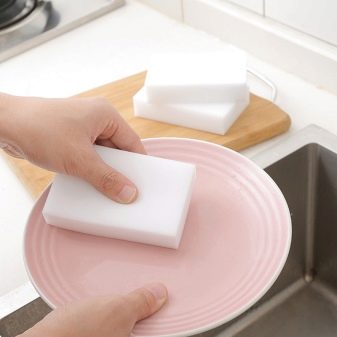
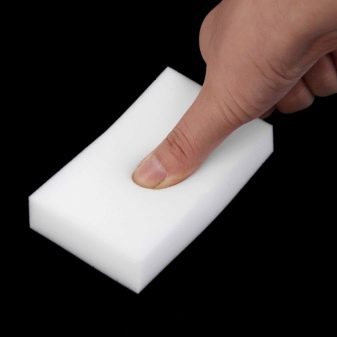
Microfiber
They are made of natural material - they are environmentally friendly and hypoallergenic. The main feature is its good ability to absorb liquids. This makes it possible not to use too much detergent. Suitable for fragile or already damaged surfaces. It is a sponge, more like a small towel. It washes away frozen dirt poorly, gets dirty quickly, instantly absorbs any liquids, including fat and so on. Often, stains form and remain on the sponge almost immediately. Not long lasting, but expensive... Well suited for wiping surfaces.

Bamboo
It is made from natural bamboo fiber, which is also an environmentally friendly material. Does not cause irritation and allergies... It is a thin sponge with a “cover” made of fabric and a foam insert inside. It is allowed to use a sponge without using a detergent. Handles oily surfaces and dried dirt well. Due to its "soft" structure, it quickly loses its presentation and becomes unusable. Market price is higher than abrasive or foam models.
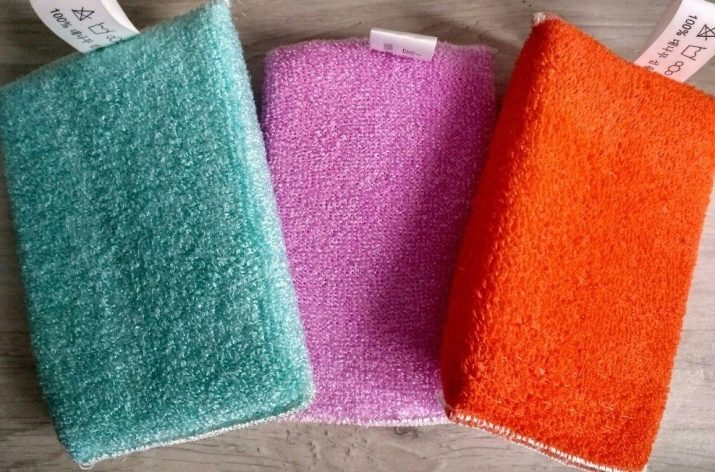
Other
Now it is quite common to find a black sponge. The black sponge is made from thin metal fibers of metal and polypropylene. Designed for washing dishes with a large layer of dirt and carbon deposits.
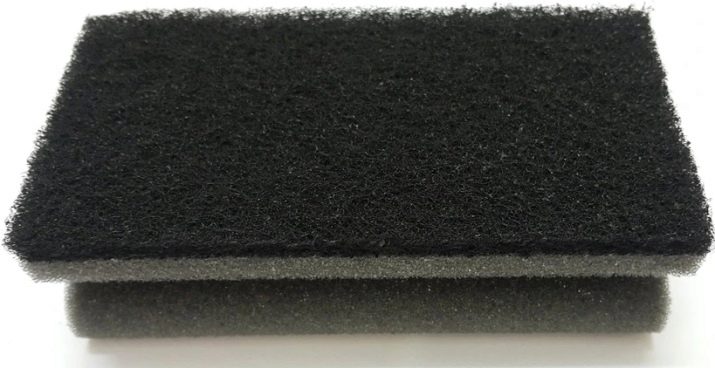
Another type of not the most popular and well-known varieties - loofah sponge... They are much harder than conventional abrasive or foam rubber counterparts, dry easier and faster, wipe off dirt well, and do not cause allergies. The main advantage is a long service life, up to several months.
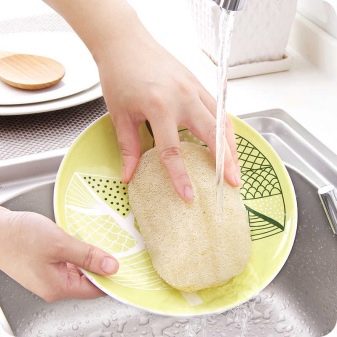

It is worth paying attention to japanese spongesthat appeared on the domestic market just a few years ago. They have three layers - a hard layer is intended for washing dried dirt, a softer layer is for dishes with a fragile coating, and thanks to the middle layer, foam appears. There are three types of hardness - high ("hard" sponge), medium ("medium" sponge) and low ("soft" sponge).
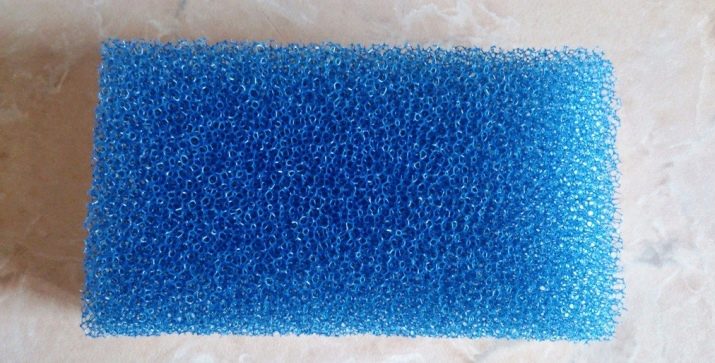
Brushes are a good substitute for a sponge. with a handle and tough natural bristles. Some are equipped with detergent dispensers.
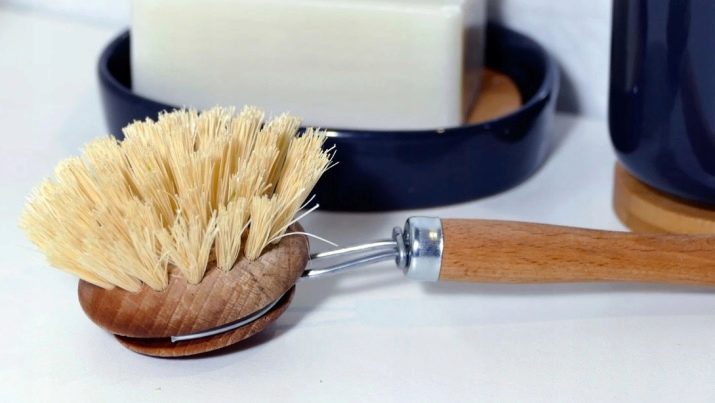
What are the sizes and shapes?
In general, the sizes of the sponges are produced for reasons of convenience when used with one hand. The most common option is a relatively bulky rectangular sponge. It is traditionally considered the most convenient, and therefore the most versatile. The second most popular shape is round. Such rounded products are often used for washing dishes of the same shape - deep cups, bowls, and so on.

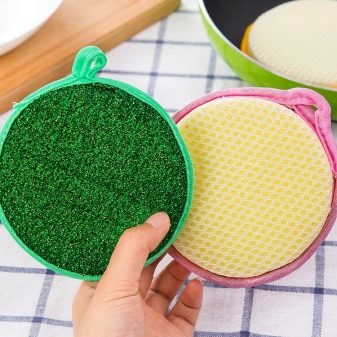
There are also small sponges for washing small dishes or hard-to-reach places. Models with a handle and a dispenser can boast of unusual, but at the same time laconic forms. Some of them are sold with drain racks. The handles can be small and wide, or long and narrow.

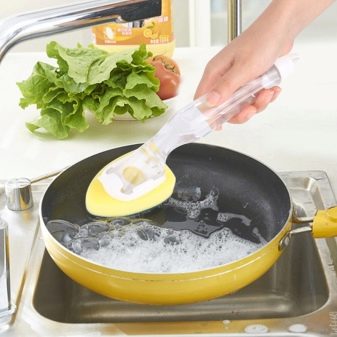
The record holders for the largest number of forms among sponges are silicone models. Modern production has established the production of products in the form of apples, hearts, ovals, curved fanciful figures of all colors. Unusual shapes and sizes in this case, as has already become obvious, are just a marketing ploy to increase sales.
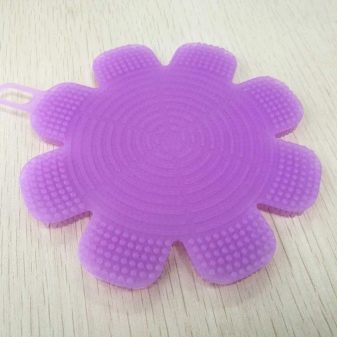
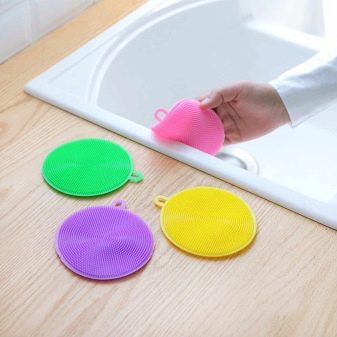
Top manufacturers
You can see that in any store prices are rarely in the same category, and sometimes the price range is rather big. There are not many reasons for this - it all depends on the number of products in the package, the material of manufacture and the manufacturer.
Silicone models are rarely found in supermarkets and are more often sold online or at specific points of sale.
One of the most popular manufacturers of dishwashing sponges in Russia - Freken BOK. The right to manufacture belongs to the company "Impex", which is a large concern specializing in the production of non-food products. The products are getting good reviews.
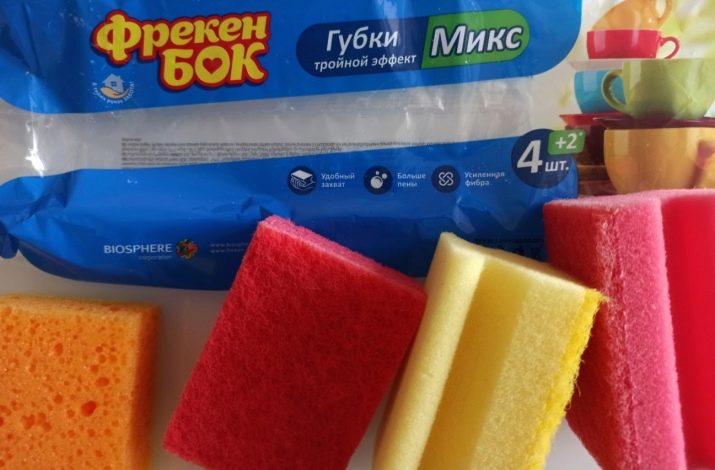
Another manufacturer whose products can often be seen on store shelves is Paclan... The brand is part of the European holding CeDo Ltd.The main office is located in Frankfurt, and production is dispersed in Poland, Great Britain and China.
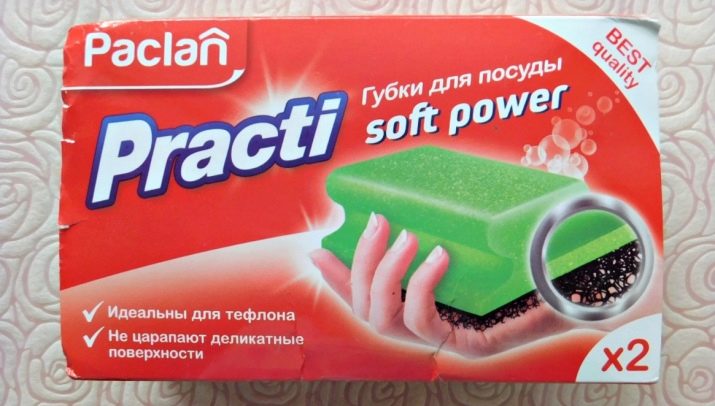
Sponges manufacturer York also became a frequent helper tool. This Polish manufacturer has been one of the market leaders for over 20 years. And also one cannot fail to note the huge number of Chinese manufacturers, whose products sometimes make up half of the range. Despite a large number of prejudices, some of the products are of good quality and long service life.
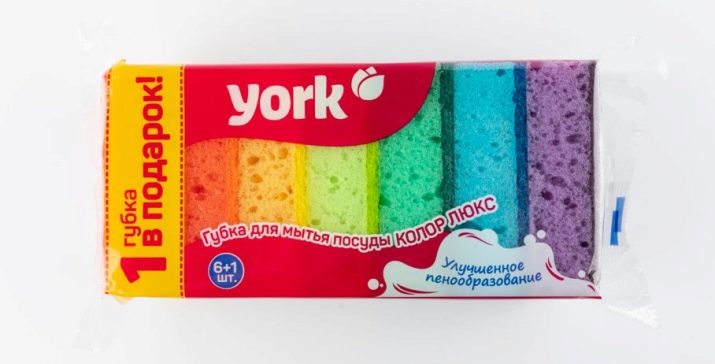
Criterias of choice
In order to choose the right sponge for yourself, not only for washing dishes, but also for cleaning surfaces, you need to focus on a number of characteristics.
-
Product dimensions. Standard foam sponges may not be suitable for everyone. Some people like to use small pieces, while others prefer large sponges that cover a relatively large area.
-
Manufacturing material. The main requirement is that the sponge must maintain its integrity when using a chemical agent. Simply put, the product should not crumble, exfoliate, bleach or release substances when interacting with the composition of the product.
-
Price... Often this criterion becomes the most important when choosing a product. This is not entirely correct. In general, prices for one variety of sponges from different manufacturers do not differ much. Most of the new types of sponges are not purchased by customers due to their rather high price. Nevertheless, it is recommended to be more careful with the purchase of this item, choosing a product according to its purpose, and not according to the price.
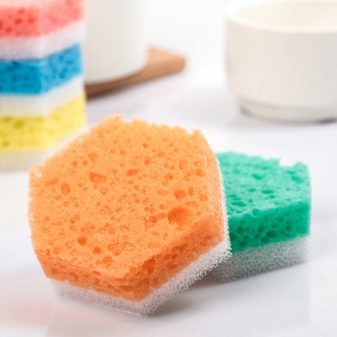
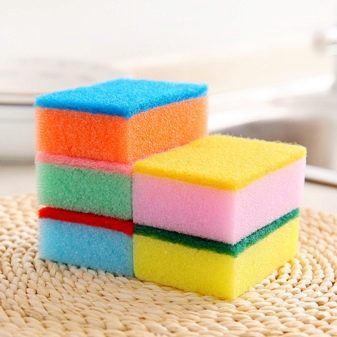
It must also be remembered that a sponge is bad if it requires a lot of detergents. If you find such a phenomenon, then it is advisable to get rid of the products.
Storage and use tips
The care and storage of the sponge is directly related to its special structure - it is porous. A porous or perforated surface perfectly absorbs any moisture, and with it small particles of dirt.
Perhaps it is quite well-known that the sponge should not be in constant contact with water. It should not lie at the bottom of the sink or in the part of it where water often drips. The ideal device for storing sponges are all kinds of hooks and stands with holes for water to drain. When stored this way, the product will not harbor any kind of bacteria. It is also worth remembering that after each use the sponge should be squeezed out as dry as possible. It is undesirable to store the product in a closed cabinet or in an unventilated place.


The most budget foam sponges with frequent use need to be changed once a week. Dirt and especially food pieces are practically not washed out of them. Cellulose products last longer - from 1 to 2 months. The easiest way in this regard is with fabric sponges - they can be replaced already after 60 washes. With proper, gentle and infrequent washing, such products are able to maintain their structure for a long time (up to several years).
It is recommended to clean the sponge from time to time in the dishwasher, if available in the house.
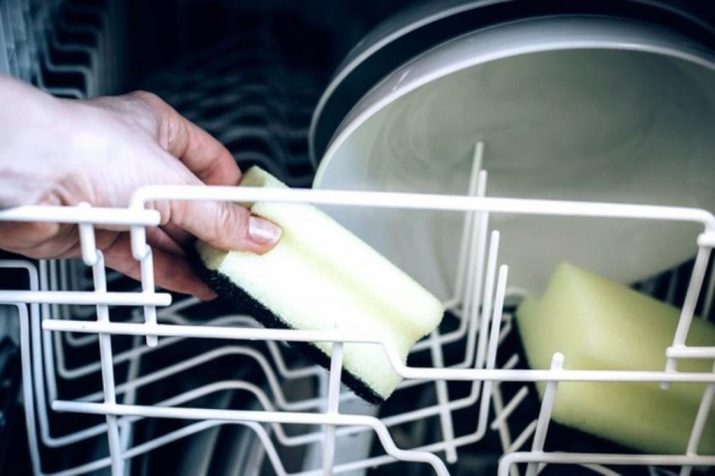
Another way to disinfect a sponge at home is to soak it in a vinegar solution. Silicone models must be poured over with boiling water once in a certain period of time.
Immediately, you need to throw out the product in the event that it began to smell unpleasant, change color, greatly changed its initial shape, began to crumble and even crumble. The latter is especially true for metal sponges. Once they begin to crumble, they can injure. It is undesirable to use a sponge for other purposes, as well as to wash dishes, tiles, stove, windows and so on with one product. This may make the cleaning process less efficient and the sponge will wear out much faster.

It is worth noting that an ordinary abrasive sponge is not always the solution to all problems.As already mentioned, new types of sponges not only allow better wiping off of dirt, but also do not damage surfaces. With the right choice of a pleasant and useful sponge for the household, you can not only make washing or cleaning easier, but also love it.









